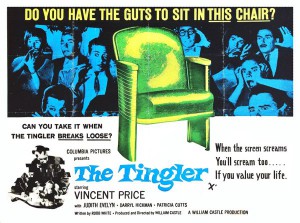Beware the monster of change management: THE MAGNIFIER
For his 1959 horror movie The Tingler, director/producer William Castle had movie theater seats rigged with buzzers to scare moviegoers during a scene when the Tingler creature is loose in a theater. Patrons in those seats probably didn’t enjoy the jolt—or making a spectacle of themselves because of the Tingler’s “attack.”
If you’re managing the implementation of new processes and tools as part of your job, you’re in a hot seat of your very own—and you need to be on the lookout for another horrifying monster: THE MAGNIFIER.
When you’re determining how changes will support corporate goals and calculating the potential return on investment (ROI) for process improvements, it’s easy to get caught up in the excitement generated by the positive things that new processes and tools will bring.
But don’t be lulled into a false sense of security by all the goodness. Lurking in the darkness is the Magnifier, and it will pounce on you if you let your guard down.
So, what is the Magnifier? It’s a phenomenon I’ve witnessed again and again on process implementations: the very act of process change can magnify existing personnel problems in an organization.
For example, if employees do not have a significant understanding of the company’s products and goals, they may create a lot of busy work to mask their lack of domain knowledge. When it comes time to update processes, “busy worker bees” want the details of their unimportant work codified as part of the new processes to make themselves relevant and indispensable (at least in their own minds) in the new workflow. These employees are less interested in the company’s goals than saving their own skins, and that trait becomes even more evident in times of change.
Employees with control issues are highly inflexible and want everything done their way. During process change, they will take a “my way or the highway” approach. For example, if they are dead set on a particular tool set, they will sandbag the tool selection process by exaggerating the feature set of their favored tool and by overemphasizing “problems” with other tool solutions.
Before you think I’m wallowing in unproductive negativity here, please understand I have witnessed the preceding poor behavior on multiple consulting projects (and I’m not even close to cataloging all the bad stuff I’ve seen). As the manager of a process change project, you must be prepared to fight the Magnifier. Effective weapons against it include:
- Outlining clear business goals for process change. If a proposed tool or process does not support the company’s end goals, it should not be part of the solution.
- Establishing clear communication among all parties. Start the communication channels up early as possible, and involve everyone, even those who are indirectly affected by the process changes. The company’s business goals should be front and center as part of all change-related conversations. As the project manager, you need to differentiate between legitimate concerns and outright recalcitrance during conversations. Pushback from others can help you identify weaknesses in the proposed workflow that you had not considered.
- Hiring a consultant, even just part-time. A consultant has seen the Magnifier do its evil thing on other projects and can therefore help you locate and dispose of it early—before it does too much damage. Because consultants come from outside the company, many employees give what they say more credence, even if the consultants end up repeating the very things you’ve been saying all along. A consultant can also act as the “bad cop” in unpleasant situations, particularly ones involving personnel changes (detailed in the next bullet).
- Realizing that successful change management may depend on personnel changes. Implementing new tools and processes is not going to magically transform poor employees into model workers. In fact, bad employees will have a negative impact on process change. If an employee’s recalcitrance is having significantly detrimental effects, consider reassigning them to another project (for example, maintaining the legacy system), placing them on a performance plan, or even terminating their employment. You must weigh the employee’s value to the company against the drag he or she is creating on the project.
Have you fought off the Magnifier in past projects? Please detail your battle scars in the comments below.




Vinish Garg
Change management when planned for the entire organization’s workflow often marginalize documentation teams and give more importance to the teams in strategy, design, production, and marketing. I worked for a company where change management was so silently planned that there were all kinds of ripples when at lunch or coffee machine. All it meant was insecurity, doubts, and gossip, driving all the work culture to dust. The team reduced by 35% within one month but the business learnt nothing. Unfortunate.
However I had a good fortune to be a part of comprehensive and well-executed change management where we saw “Outlining clear business goals for process change.” All the employees and contractors from all departments were equally involved, participative, and informed. As a result, the entire workforce worked 4 hours a day extra, without any added remuneration or bonus, for two months, to execute the plan successfully and in positive spirit.